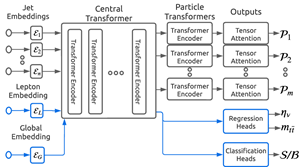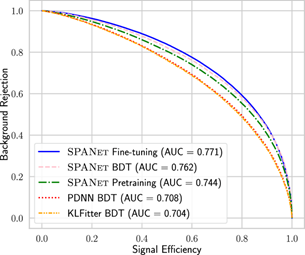Recent Progress in Reconstructing Heavy Particle Decays Using Machine Learning Algorithm
A new machine learning algorithm, which significantly improves the precision of measuring the top quark mass and enhances the sensitivity to the Higgs boson or new particle production, has been developed by Prof. Hideki Okawa, a professor at the Institute of High Energy Physics of the Chinese Academy of Sciences, and his collaborators in University of California, Irvine and University of Washington. This work was published in Nature Communications Physics on April 30 (M. Fenton, A. Shmakov, H. Okawa, et al., Commun Phys 7, 139 (2024)).
In high-energy collider experiments, the key to reconstructing heavy particles (such as the top quarks, Higgs and W/Z bosons, etc.) is to identify their decay products, such as the quarks decaying and/or hadronizing to form a cluster of particles, thereby forming jets in the detector. The origin of the jets is often difficult to determine. Traditional algorithms consider all possible permutations of jets per event and systematic uncertainty. As the center-of-mass energy and luminosity of the collider increase, the jet multiplicity increases as well, and the number of combinatorics diverges exponentially. This fact makes correctly assigning jets to each original particle significantly challenging.
To overcome this issue, the researchers have developed a machine learning algorithm called the Symmetry Preserving Attention Networking (SPA-NET). The attention mechanism is the foundation of the Transformer architecture, known for its use in the Chat GPT. Unlike the original attention mechanism, this algorithm not only possesses permutation invariance but also can effectively incorporate symmetries in processes, such as two-body or three-body decays. Furthermore, this algorithm can also handle various types of physics objects and observables (such as leptons, jets, and missing transverse momentum), thanks to the Transformer architecture, which can simultaneously perform regression and event classification, leading to improvement in efficiency and accuracy.
This algorithm is applied to three flagship analyses at the Large Hadron Collider (LHC) evaluated with simplified detector simulation (Delphes) datasets: the ttH(àbb) and top quark mass measurements, and searching for a hypothetical heavy particle Z' decaying to a top-quark pair. With the LHC Run 2 (3) data statistics, the sensitivity to the ttH and Z' signals with SPA-NET is expected to reach 3(5)σ, whereas the traditional methods cannot. In addition, with the LHC Run 2 data statistics, the precision of the top quark mass measured with this algorithm would improve by 15% compared to the traditional methods. Compared to other machine learning methods, SPA-NET significantly improves the measurement precision and signal sensitivity to new physics, making it the most efficient, high-performing method for event reconstruction to date.
This new machine learning algorithm can be considered for many other physics analyses and provides innovative methods for the LHC and future colliders.

Fig.1. Diagram of the Symmetry Preserving Attention Network (SPA-NET) architecture

Fig.2. Receiver operating curve for networks trained to distinguish ttH from background
The paper link: https://doi.org/10.1038/s42005-024-01627-4
Contact Information
Ms. JIA Yinghua
jiayh@ihep.ac.cn